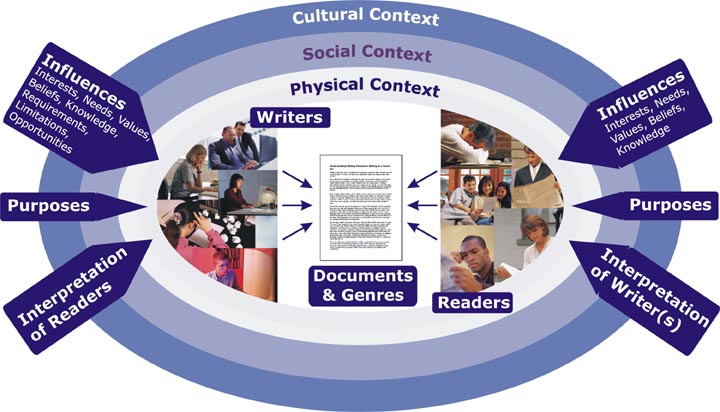Sample
Transition to Next Activity (remember to feel free to write your
own!) |
The Writing Situation Model (10 minutes) |
Introduce the Writing Situation ModelThe goal for this discussion is to illustrate how context shapes the interactions between writers and readers. Writers make choices based on their physical, social and cultural contexts as well as their purposes for writing. In the same sense, readers come to a text by way of their own needs and interests. Thinking about interactions between writers and readers helps to ensure that meaning is clearly communicated. For this activity, use the model from "Understanding Writing Situations: Writing as a Social Act" to show students how readers and writers interact. This model is available on Writing@CSU (https://writing.colostate.edu/guides/processes/writingsituations/).You can either draw a diagram on the board or make an overhead (we recommend making an overhead). Explain to students that you will first review the model in general terms, and then they will discuss it with more detail in relation to their homework. 
Be sure to cover the following points (in whatever order feels right for you): · Writers have purposes for writing · Usually these purposes emerge from the writer's cultural or social context (something happens outside the writer that creates a need to write - something to respond to) · Writes make choices based on the context they are writing for (writing a letter home to your parents asking for money is a different than writing a letter to an organization to ask for contributions for a good cause). Therefore, different contexts will pose different requirements, limitations, and opportunities for a writer. · In addition to context, writers also need to think about readers. · Readers have various needs and interests which are likewise determined by their contexts (their background, environment and experience). · In order to communicate effectively, a writer must anticipate what their readers' needs and interests are. |
Sample Transition to Next ActivityAs a transition, review the key points from the writing situation model. Students will have read the writing guide as homework for today (Understanding Writing Situations: Writing as a Social Act at https://writing.colostate.edu/guides/processes/writingsituations/). Use this review of the writing situation model as a transition into the next activity. You might say something like the following: Now that we understand the diagram, let's apply our homework to it so that we can fully understand how it relates to the writing we do ourselves. |